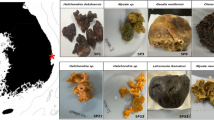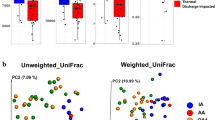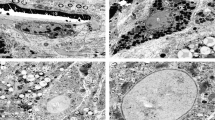Abstract
The impact of elevated seawater temperature on bacterial communities within the marine sponge Rhopaloeides odorabile was assessed. Sponges were exposed to temperatures ranging between 27 and 33 °C. No differences in bacterial community composition or sponge health were detected in treatments between 27 and 31 °C. In contrast, sponges exposed to 33 °C exhibited a complete loss of the primary cultivated symbiont within 24 h and cellular necrosis after 3 days. Furthermore, denaturing gradient gel electrophoresis (DGGE) and clone sequence analysis detected a dramatic shift in bacterial community composition between 31 and 33 °C. Within the first 24 h most of the DGGE bands detected in samples from 27 to 31 °C were absent from the 33 °C sponges whereas eight bands were detected exclusively in the 33 °C sponges. The 16S rRNA sequencing revealed that most of the microbes from sponges exposed to 27–31 °C had highest homology to known sponge-associated bacteria. In contrast, many of the microbes from sponges exposed to 33 °C were similar to sequences previously retrieved from diseased and bleached corals. The 16S rRNA clone library analysis also detected a significant shift in bacterial community structure. The 27 °C library was composed of Proteobacteria, Actinobacteria, Nitrospira, Acidobacteria and Chloroflexi whereas the 33 °C library contained sequences from the Proteobacteria, Bacteroidetes and Firmicutes. The clear shifts in community composition at elevated temperatures can be attributed to the loss of symbionts and to the establishment of alien microbial populations including potential pathogens. Breakdown of symbioses and stress in the sponge occurred at temperatures identical to those reported for coral bleaching, indicating that sponges may be similarly threatened by climate change.
Similar content being viewed by others
Log in or create a free account to read this content
Gain free access to this article, as well as selected content from this journal and more on nature.com
or
Accession codes
References
Altschul SF, Madden TL, Schäffer AA, Zhang J, Zhang Z, Miller W et al. (1997). Gapped BLAST and PSI-BLAST: a new generation of protein database search programs. Nucleic Acids Res 25: 3389–3402.
Bachinski N, Koziol C, Batel R, Labura Z, Schroder HC, Müller WEG . (1997). Immediate early response of the marine sponge Suberites domuncula to heat stress: reduction of trehalose and glutathione concentrations and glutathione S-transferase activity. J Exp Mar Biol Ecol 210: 129–141.
Berkelmans R . (2001). Bleaching, upper thermal limits and temperature adaptation in reef corals. PhD thesis School of Marine Biology, James Cook University, Australia.
Berkelmans R, De’ath G, Kininmonth S, Skirving W . (2004). A comparison of the 1998 and 2002 coral bleaching events on the Great Barrier Reef: spatial correlation, patterns, and predictions. Coral Reefs 23: 74–83.
Berkelmans R, Willis BL . (1999). Seasonal and local spatial patterns in the upper thermal limits of corals on the inshore Central Great Barrier Reef. Coral Reefs 18: 219–228.
Bohannan BJ, Hughes J . (2003). New approaches to analyzing microbial biodiversity data. Curr Opin Microbiol 6: 282–287.
Brown BE . (1997). Coral bleaching: causes and consequences. Coral Reefs 16: S129–S138.
Enticknap JJ, Kelly M, Peraud O, Hill RT . (2006). Characterization of a culturable alphaproteobacterial symbiont common to many marine sponges and evidence for vertical transmission via sponge larvae. Appl Environ Microbiol 72: 3724–3732.
Felsenstein J . (1993). PHYLIP (Phylogenetic Inference Package) version 3.5c. Department of Genetics, University of Washington: Seattle, WA.
Ferris MJ, Muyzer G, Ward DM . (1996). Denaturing gradient gel electrophoresis profiles of 16S rRNA-defined populations inhabiting a hot spring microbial mat community. Appl Environ Microbiol 62: 340–346.
Fieseler L, Horn M, Wagner M, Hentschel U . (2004). Discovery of the novel candidate phylum ‘Poribacteria’ in marine sponges. Appl Environ Microbiol 70: 3724–3732.
Fisher RA, Corber AS, Williams CB . (1943). The relation between the number of species and the number of individuals in a random sample of an animal population. J Anim Ecol 12: 42–58.
Good IJ . (1953). The population frequencies of species and the estimation to the population parameters. Biometrika 40: 237–264.
Hentschel U, Hopke J, Horn M, Friedrich AB, Wagner M, Hacker J et al. (2002). Molecular evidence for a uniform microbial community in sponges from different oceans. Appl Environ Microbiol 68: 4431–4440.
Hughes TP, Baird AH, Bellwood DR, Card M, Connolly SR, Folke C et al. (2003). Climate change, human impacts, and the resilience of coral reefs. Science (NY) 301: 929–933.
Hurlbert SH . (1971). The nonconcept of species diversity: a critique and alternative parameters. Ecology 52: 577–586.
IPCC (2007). Climate Change 2007: The Physical Basis. Contribution of Working Group I to the Fourth Assessment Report of the Intergovernmental Panel on Climate Change: Geneva. Cambridge University Press: Cambridge, UK.
Klussmann-Kolb A, Brodie GD . (1999). Internal storage and production of symbiotic bacteria in the reproductive system of a tropical marine gastropod. Mar Biol 133: 443–447.
Koziol C, Batel R, Arinc E, Schröder HC, Müller WEG . (1997). Expression of the potential biomarker heat shock protein 70 and its regulator, the metazoan DnaJ homolog, by temperature stress in the sponge Geodia cydonium. Mar Ecol Prog Ser 154: 261–268.
Krasko A, Scheffer U, Koziol C, Pancer Z, Batel R, Badria FA et al. (1997). Diagnosis of sublethal stress in the marine sponge Geodia cydonium: application of the 70 kDa heat-shock protein and a novel biomarker, the Rab GDP dissociation inhibitor, as probes. Aquat Toxicol 37: 157–168.
Lafi FF, Garson MJ, Fuerst JA . (2005). Culturable bacterial symbionts isolated from two distinct sponge species (Pseudoceratina clavata and Rhabdastrella globostellata) from the Great Barrier Reef display similar phylogenetic diversity. Microb Ecol 50: 213–220.
Ludwig W, Strunk O, Klugbauer S, Klugbauer N, Weizenegger M, Neumaier J et al. (1998). Bacterial phylogeny based on comparative sequence analysis. Electrophoresis 19: 554–568.
Magurran AE . (1988). Ecological Diversity and its Measurement. Princeton University Press: Princeton, NJ.
Maidak BL, Cole JR, Parker Jr CT, Garrity GM, Larsen N, Li B et al. (1999). A new version of the RDP (Ribosomal Database Project). Nucleic Acids Res 27: 171–173.
Marchesi JR, Sato T, Weightman AJ, Martin TA, Fry JC, Hiom SJ et al. (1998). Design and evaluation of useful bacterium-specific PCR primers that amplify genes coding for bacterial 16S rRNA [published erratum appears in Appl Environ Microbiol 1998; 64(6): 2333] Appl Environ Microbiol 64: 795–799.
Muyzer G, de Waal EC, Uitterlinden AG . (1993). Profiling of complex microbial populations by denaturing gradient gel electrophoresis analysis of polymerase chain reaction-amplified genes coding for 16S rRNA. Appl Environ Microbiol 59: 695–700.
Nogales B, Aguilo-Ferretjans MM, Martin-Cardona C, Lalucat J, Bosch R . (2007). Bacterial diversity, composition and dynamics in and around recreational coastal areas. Environ Microbiol 9: 1913–1929.
Schmidt EW, Obraztsova AY, Davidson SK, Faulkner DJ, Haygood MG . (2000). Identification of the antifungal peptide-containing symbiont of the marine sponge Theonella swinhoei as a novel delta-proteobacterium, ‘Candidatus Entotheonella palauensis’. Mar Biol 136: 969–977.
Sekar R, Mills DK, Remily ER, Voss JD, Richardson LL . (2006). Microbial communities in the surface mucopolysaccharide layer and the black band microbial mat of black band-diseased Siderastrea siderea. Appl Environ Microbiol 72: 5963–5973.
Shannon CE, Weaver W . (1963). The Mathematical Theory of Communication. University of Illinois Press: Urbana, IL.
Sogin ML, Morrison HG, Huber JA, Welch DM, Huse SM, Neal PR et al. (2006). Microbial diversity in the deep sea and the underexplored ‘rare biosphere’. Proc Natl Acad Sci USA 103: 12115–12120.
Staley JT, Castenholz RW, Colwell RR, Holt JG, Kane MD, Pace NR et al. (1997). The Microbial World: Foundation of the Biosphere. The American Academy of Microbiology: Washington, DC.
Taylor MW, Radax R, Steger D, Wagner M . (2007). Sponge-associated microorganisms: evolution, ecology, and biotechnological potential. Microbiol Mol Biol Rev 71: 295–347.
Taylor MW, Schupp PJ, Dahllof I, Kjelleberg S, Steinberg PD . (2004). Host specificity in marine sponge-associated bacteria, and potential implications for marine microbial diversity. Environ Microbiol 6: 121–130.
Thompson FL, Barash Y, Sawabe T, Sharon G, Swings J, Rosenberg E . (2006). Thalassomonas loyana sp. nov., a causative agent of the white plague-like disease of corals on the Eilat coral reef. Int J Syst Evol Micr 56: 365–368.
Unson MD, Holland ND, Faulkner DJ . (1994). A brominated secondary metabolite synthesized by the cyanobacterial symbiont of a marine sponge and accumulation of the crystalline metabolite in the sponge tissue. Mar Biol 119: 1–11.
Vacelet J . (1975). Etude en microscopie electronique de l′association entre bacteries et spongiaires du genre Verongia (Dictyoceratida). J Microsc Biol Cell 23: 271–288.
Webster NS, Hill RT . (2001). The culturable microbial community of the Great Barrier Reef sponge Rhopaloeides odorabile is dominated by an alpha proteobacterium. Mar Biol 138: 843–851.
Webster NS, Hill RT . (2007). Vulnerability of marine microbes on the Great Barrier Reef to climate change. In: Johnson JE, Marshall PA (eds). Climate Change and the Great Barrier Reef. Great Barrier Reef Marine Park Authority and the Australian Greenhouse Office: Townsville, pp 97–120.
Webster NS, Negri AP, Webb RI, Hill RT . (2002). A spongin-boring alpha proteobacterium is the etiological agent of disease in the Great Barrier Reef sponge, Rhopaloeides odorabile. Mar Ecol Prog Ser 232: 305–309.
Webster NS, Watts JE, Hill RT . (2001a). Detection and phylogenetic analysis of novel crenarchaeote and euryarchaeote 16S ribosomal RNA gene sequences from a Great Barrier Reef sponge. Mar Biotechnol (NY) 3: 600–608.
Webster NS, Webb RI, Ridd MJ, Hill RT, Negri AP . (2001b). The effects of copper on the microbial community of a coral reef sponge. Environ Microbiol 3: 19–31.
Webster NS, Wilson KJ, Blackall LL, Hill RT . (2001c). Phylogenetic diversity of bacteria associated with the marine sponge Rhopaloeides odorabile. Appl Environ Microbiol 67: 434–444.
Wickins JF . (1983). Studies on marine biological filters. Water Res 17: 1769–1780.
Wilkinson CR . (1979). Nutrient tranlocation from symbiotic cyanobacteria to coral reef sponges. In: Levi C, Boury-Esnault N (eds). Colloques Internationaux du Centre national de la Recherche scientifique: Paris, pp 373–380.
Wilkinson CR . (1983). Net primary productivity in coral reef sponges. Science, NY 219: 410–412.
Acknowledgements
We thank C Wolff, A Duckworth, C Battershill and E Evans-Illidge for assistance with the field collection.
Author information
Authors and Affiliations
Corresponding author
Additional information
Supplementary Information accompanies the paper on The ISME Journal website (http://www.nature.com/ismej)
Rights and permissions
About this article
Cite this article
Webster, N., Cobb, R. & Negri, A. Temperature thresholds for bacterial symbiosis with a sponge. ISME J 2, 830–842 (2008). https://doi.org/10.1038/ismej.2008.42
Received:
Revised:
Accepted:
Published:
Issue date:
DOI: https://doi.org/10.1038/ismej.2008.42
Keywords
This article is cited by
-
Microbiome species diversity and seasonal stability of two temperate marine sponges Hymeniacidon perlevis and Suberites massa
Environmental Microbiome (2023)
-
Future ocean conditions induce necrosis, microbial dysbiosis and nutrient cycling imbalance in the reef sponge Stylissa flabelliformis
ISME Communications (2023)
-
Comparative seasonal analysis of Eri silkworm (Samia ricini Donovan) gut composition: implications for lignocellulose degradation
Environmental Science and Pollution Research (2023)
-
Distribution and Abundance of Intertidal Sponge (Porifera) Communities in Coral Reefs of Singapore
Ocean Science Journal (2023)
-
Oceanographic setting influences the prokaryotic community and metabolome in deep-sea sponges
Scientific Reports (2022)



